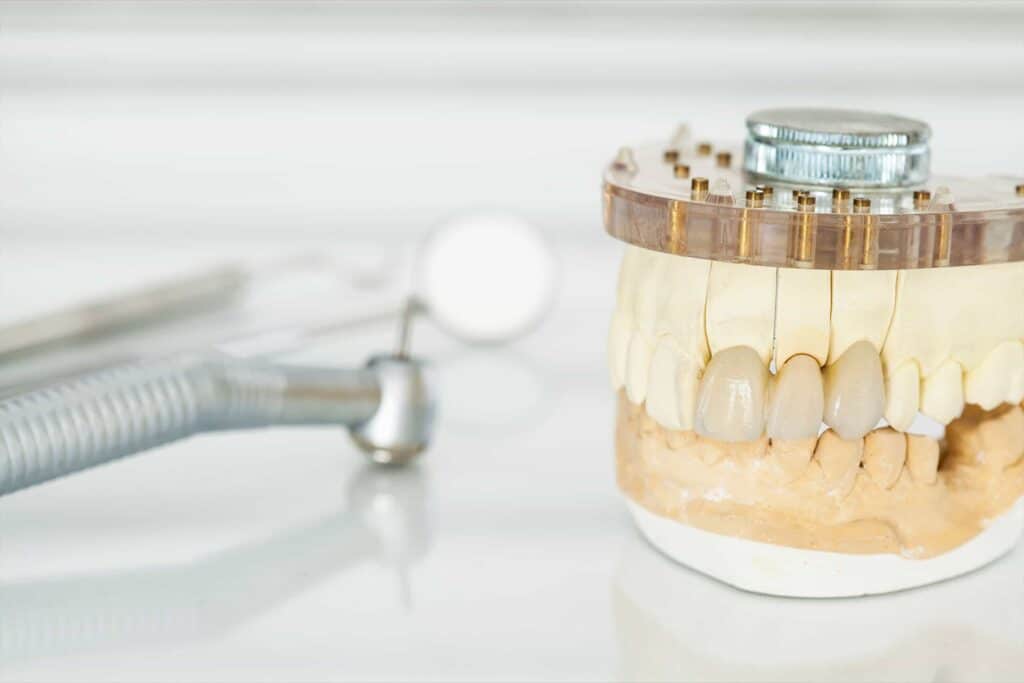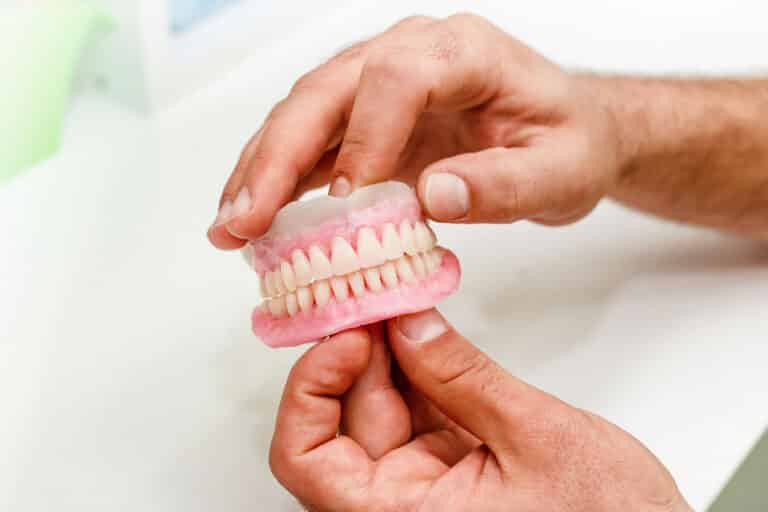There are numerous reasons to straighten your teeth, whether it be to make oral hygiene easier to complete, to correct a misaligned bite, or simply to create a beautiful smile. Most people are aware of what orthodontic treatment can do for crooked and crowded teeth as well as the traditional option of metal braces.
For those unaware, there are two primary ways to straighten teeth: traditional metal braces or invisible braces, also known as the popular brand of clear aligners called Invisalign. Traditional braces have the classic look of visible metal brackets that are bonded directly to the teeth. They have a wire that attaches across each bracket that is either held in by the bracket or with rubber bands.
How do Traditional Braces Work?
Traditional braces work by exerting a constant low amount of pressure on the teeth in a pulling motion. This action is different than clear aligner or invisalign treatment, which acts by pushing crooked teeth into the right position. The end result is the same, however the method getting there is different.
The key is constant pressure which is thought to signal to the bone cells called osteocytes to remodel around the tooth. This theory states that the osteocytes remove bone in the direction the tooth is being pulled and forms bone behind the tooth as its moved into the proper position.
While the different movements of push vs pull may not seem like a big deal, it can mean the difference between using traditional braces or clear aligners. There are some movements where you cannot push teeth. Sometimes the only option is to pull the tooth into place. One such instance is an impacted tooth, often a maxillary canine. When a tooth doesn’t erupt normally and is stuck in bone, using traditional braces is the only option to pull the tooth into place.
The amount of force required to move teeth is not a significant amount. The key is that force has to be constant in order to actually move teeth.
Advantages and Disadvantages of Traditional Braces
When comparing traditional metal braces with clear aligners or Invisalign, each has its own advantages and disadvantages. When discussing which option is the best for you or your child, keep in mind that there are people who are not candidates for one over the other. Your dentist can further explain the key difference between the types of braces.
Advantages of Traditional Braces
Traditional metal braces have been the treatment option of choice for dentists and orthodontists for many decades. Like gold crowns, they have a proven track history to straighten your teeth. There are also capable of a few tooth movements that clear aligners cannot. A good example of this one of the natural teeth, often an upper front tooth, is completely embedded in bone. When this is the case, metal braces is the only option to pull the tooth into alignment. Once the back or front surface of the tooth is exposed, brackets are placed on the teeth and wires and/or chain are attached to pull the teeth into place. Clear braces are an unacceptable orthodontic treatment option for this specific problem
Perhaps the bigger advantage of traditional braces is compliance. The metal brackets are bonded onto the front surface of the teeth and don’t easily come off. This means the orthodontic treatment is always working. Invisalign style braces are removable and as a result do not work on the teeth when they are not worn. For a patient who doesn’t wear the clear braces for the prescribed 22 hours a day will not see the correct progression of teeth movement. This delays treatment, can result in poor results, longer total treatment time, and more expenses as well.
Disadvantages of Traditional Braces
While a good option, traditional braces do have their downsides as well. Wearing braces, particularly metal ones, can have negative connotations because the visible metal is unesthetic. In today’s shrinking world, having crowded teeth and wearing traditional braces are both not aesthetically pleasing.
A bigger concern for your dentist or orthodontist is the ability to regularly and effectively keep the teeth clean. The brackets, rubber bands, and wires make it extremely difficult to keep up regular dental hygiene. Lack of dental hygiene will lead to other dental issues such as gum disease and dental cavities on the teeth. Once the tooth structure has rotted away, it won’t come back and may potentially set up the patient for a future of constant teeth and gum issues.
Another disadvantage is the potential problem with trauma, most often seen with sports. Since the brackets are perfectly smooth, they can lacerate the cheek and lips during contact. This can be a problem for active patients, especially for those who play contact sports such as football or martial arts.
Due to the location of the brackets, traditional braces often do not cause issues with speaking properly while Invisalign may. When this does occur, often it is a minor problem that will often resolve by itself with time.
Traditional Braces Compared to Newer Technologies
While traditional braces have been a tried and true method, newer dental technology has given rise to more orthodontic options. There are other types of braces that still use brackets, brackets that don’t require rubber bands, or even a style of brackets that are attached to the lingual (or inside) surface.
Ceramic Braces
Ceramic braces are still considered a type of ‘traditional ortho’, however it utilizes brackets that are made out of a ceramic. These still use wires to gradually straighten your teeth and are not removable. However these ceramic or porcelain braces are less noticeable since they aren’t metal. Since metal in the mouth isn’t a visible, naturally occuring substance, the appearance of any metal in the mouth sticks out like sore thumb. While it doesn’t complete hide braces, ceramic braces may be a good option for those who need traditional braces but have esthetic concerns.
If you elect ceramic braces, keep in mind that they are more likely to fracture due to the inherent physical properties of ceramic vs metal. This may result in either additional expenses and/or visits to the dentist or orthodontist.
Self-Ligating System
Traditional braces require rubber bands to keep the metal wires in place. Without something to hold the wire in place, the forces cannot be properly applied to properly move the teeth. Self-ligating brackets remove the need for the bands to hold the wire in place. One thing to keep in mind is that some patients who end up taking ownership of their teeth, may want the ability to personalize the rubber bands on their teeth.
Lingual Braces
While traditional braces are placed on the facialThe ‘outside’ surface of the teeth that directly face either the lips or cheeks. surface, lingual braces are placed on the opposite surface closer to the tongue. These braces are much, much less visible to the naked eye. Although this may seem like the best way to blend esthetics with metal braces, this type of braces is not done very frequently. In fact there is a good chance your orthodontist or dentist will choose to not even offer this service because there are many downsides.
Due to lingual braces having the brackets placed on the tongue side of teeth, they will come into direct contact with your tongue. As many people have a small jaw to begin with, this creates even less space for the tongue. Additionally, the tongue will get very irritated while eating. The quality of life is significantly poorer with minimal benefits when compared to other options. Additionally this style may have a higher cost as they are much more difficult to place.
Clear Aligners (Invisalign)
Clear aligners, also called clear braces, are an increasingly popular style of braces. The most well known brand is called Invisalign. Once thought to be a fad, clear aligner technology has improved significantly over the past couple of decades. This resulted in many orthodontists and dentists who were once skeptical to embrace the technology.
Since this style of orthodontic treatment is removable, the oral health may be better post treatment. When the teeth are more easily cleansable, they will stay in good shape for a longer time.
How Do I Care for My Braces?
Taking care of your teeth is incredibly important and even moreso if you have traditional metal braces. This is because routing dental hygiene can take much longer with metal braces. Since a wire connects all the teeth within each arch, properly flossing between the teeth is impossible. Additionally the surface where the brackets are placed will build up plaque a lot easier, especially if the foods aren’t removed after eating.
Brushing
Brushing stays relatively the same with metal braces. You will still want to use a soft bristled toothbrush and ideally an electric toothbrush. Ensure you brush every surface of the tooth, but spend extra time on the surface with the bracket. Make sure you brush around the bracket and remove all plaque and food debris daily. This typically means you will need to brush for longer than the recommended 2 minutes.
Flossing
Flossing is incredibly important and should not be neglected, especially those who have traditional braces. Every interproximal contact needs to be flossed and with a physical piece of string. Water flossers are a good supplemental hygiene tool however they are not replacement for regular string floss.
The tricky part with traditional braces is the wire doesn’t allow for floss to pass through the contacts between the teeth. This means that the floss must be passed individually under the wire to properly floss. This is very time consuming and can often be the reason why those with traditional metal braces don’t floss, even adults.
Maintaining proper dental hygiene will eliminate problems that will plague the patient for many years to come. Unfortunately there are many instances where adequate dental hygiene isn’t maintained and the teeth have numerous cavities. It is likely your dentist or orthodontist has seen this happen. Depending on their philosophy, your orthodontist or dentist may elect to stop orthodontic treatment until hygiene improves.
Other Effective Cleaning Methods
While brushing and flossing are tried and true methods, it may not be practical to do in the middle of the day especially if chewy foods are eaten. Of course, these methods should be done in addition to the regular brushing and flossing. In a pinch, try these methods to keep your teeth as clean as possible for the perfect smile.
Rinsing after eating
After eating or drinking, a simple strategy is to vigorously swish with tap water for 30 seconds. This dislodges food debris from the teeth and brackets. Using a mouthrinse, either a fluoride mouthwash or antiseptic mouthwash depending on the goals, would be better than just water. However carrying around the appropriate mouthwash is not practical for some people.
Chewing gum
Using a sugar-free gum after eating or drinking is usually an effective strategy. When you chew gum, it stimulates saliva and helps to dislodge food debris from hard to reach places. However, this becomes not as effective with metal braces as the gum may get stuck in between the brackets. It doesn’t hurt to try this method, but if the gum continues to get stuck in the brackets you may want to stop.
Chewing gum is not recommended for those with jaw problems, specifically TMJ issues. The repeated motion can exacerbate problems within the joint. However this tends to be less of an issue as the most common age range for braces tends to be on the younger side and TMJ issues are more common in adults.
Do Traditional Braces Hurt?
Traditional braces should not be painful, however they can be uncomfortable right after being ‘tightened’. As teeth are moved incrementally, each increment requires a visit to the orthodontist or dentist to replace or modify the wire. This puts pressure on the teeth which can be uncomfortable, but not painful.
After each session the wire is modified or moved, give it a few days and typically the pressure subsides enough to where it’s not as noticeable. Keep in mind that there needs to be some pressure otherwise the teeth won’t move. If the pressure is too uncomfortable, speak with your orthodontist or dentist and they reduce the pressure. This may slow down the tooth movement, resulting in an overall longer length of treatment.
What Should I Eat During Treatment with Metal Braces?
As always, you should be eating a balanced diet as much as possible. This includes healthy grains, protein, fruits and vegetables while avoiding heavily processed foods and candies. You should avoid sticky or extremely hard food or candies and sugary drinks. While not an exhaustive list, some of these include:
- Hard candy such as lollipops, candy canes, toffees
- Hard foods such as nuts, hard pretzels, popcorn, jerky, or croutons
- Ice
- Sticky foods such as peanut butter or caramel
- Foods that require biting into such as corn on the cob, carrots, or apples – cut these into pieces instead
- Chips as these will easily get stuck in the braces
- Sugary sodas or energy drinks
As a general rule of thumb, you want to avoid eating foods that will knock off the brackets from the teeth or foods that already increase cavity rates.
How Long Does Treatment with Traditional Braces Last?
The length of treatment will vary depending on the complexity, however a range that covers most cases is anywhere from 6 months to 2 years. There are more complex situations that require collaboration with other disciplines such as oral surgery, dental sleep medicine, periodontics, or endodonticsA dental specialty that deals with root canals. These root canals may be completed non-surgically or may require a surgery to complete. that may increase the length of treatment.
As a general rule of thumb it is a good idea to find a dentist or orthodontist who is well versed in multiple disciples. For instance identifying and understanding how to reduce the chances of gum recession or possible sleep issues will be important to not cause or exacerbate issues in the future.
How Much Do Metal Braces Cost vs Other Orthodontic Treatments?
Most orthodontic treatment options will cost around the same, ranging from $3,500 to $7,000 with most treatments costing around $5000. If the complexity increases, generally the cost will also increase. For instance if there is a buried canine that needs to be exposed and pulled into place, that would require a minor surgery and have an additional cost.
Ceramic Braces
Ceramic braces tend to cost more their metal counterpart. This is due to the increased complexity and higher frequency of complications such as fracture.
Self-Ligating System
Self-ligating braces tend to be around the same cost as they are still metal and don’t significantly change the complexity or complication rate.
Lingual Braces
Lingual braces tend to be more expensive and there are even clinicians who don’t offer this option. This is due to the complexity of treatment as initially placing brackets and each subsequent visit are more difficult to complete.
Clear Aligners (Invisalign)
Clear aligner therapy tends to also be around the same cost as traditional braces.
Does Dental Insurance Cover Orthodontics?
Yes, many dental insurance plans will have some coverage for orthodontic work. Typically the coverage is only covered once per lifetime and is a percentage of a predetermined benefit amount. An example of this is 50% coverage up to $2,000 which is common. This means that insurance will cover half of the total treatment cost, but only up to a certain amount, $2,000 in this instance.
If you have questions or concerns about insurance coverage, speak to your dental office and they will be able to clear up any questions.
Was this post helpful?
Table of Contents
- How do Traditional Braces Work?
- Advantages and Disadvantages of Traditional Braces
- Traditional Braces Compared to Newer Technologies
- How Do I Care for My Braces?
- Do Traditional Braces Hurt?
- What Should I Eat During Treatment with Metal Braces?
- How Long Does Treatment with Traditional Braces Last?
- How Much Do Metal Braces Cost vs Other Orthodontic Treatments?
- Does Dental Insurance Cover Orthodontics?





